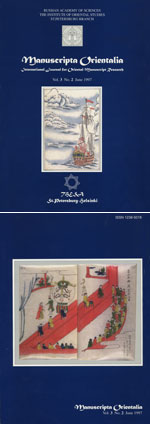|
|
| |

|

|
Sazykin A. The Oirat (Kalmyk) Version of the “The Story of Güsü-Lama” // Manuscripta Orientalia. Vol. 3. No. 2. June 1997. P. 33—38.
In the Mongol literature of the seventeenth—early twentieth centuries there were several works describing “visions” of the Buddhist hell. These works came into being for different reasons at different places and in different periods of time. Among them we find an Indian legend about Maudgalyayana (Molon-Toyin), Tibetan The Story of Choijid-dagini, Mongol The Story of Naranu-Gerel and The Story of the Maiden Fair Lotus created under the influence of the Chinese novels. The subject of “visions” of hell has been many times used in the novels of the Commentaries on the Use of Vajracchedika (the Diamond Sutra).
There circulated among the Mongol peoples a comparatively brief story about a visit to the Buddhist hell. It was more known under its short title The Story of Güsü-Lama. In the opinion of Ts. Zh. Zhamtsarano, who acquired one of the manuscripts of this work in Buryatia and donated it to the Asiatic Museum (now the St. Petersburg Branch of the Institute of Oriental Studies of the Russian Academy of Sciences), it was “an example of purely folk religious literature at the early stage of the spread of Buddhism among the Buryat people”.
The other seven manuscripts of the story, written in Old Mongol script and preserved in the Manuscript fund of the above-mentioned Institute, also originate from Buryatia. A copy of The Story of Güsü-Lama has been found also in one of the manuscript collections of Tuva.
A search we made in the rich manuscript funds of Ulan-Bator produced, however, no copies of the said work, nor it is mentioned in any of the available catalogues of Mongolian manuscripts.
Until recently there has been no evidence if this work was familiar at all to the Western Mongols (Oirats). It is not mentioned anyway in H. Luvsanbaldan's “Clear Script” and its Monuments which includes a long list of materials from Mongolia written in the Zaya-pandita script.
The only copy of The Story of Güsü-Lama written in “Clear Script” is found in the Manuscript fund of the St. Petersburg Branch of the Institute of Oriental Studies. There is no record about its origin and the time when it came to the collection. We may only suggest that it was copied in Kalmykia, because, according to the available evidence, the Oirat version had been circulated there in the past.
When comparing the Buryat and the Oirat (Kalmyk) versions one can notice a number of textual divergencies. Besides deliberate re-working of the text manuscript С 391 contains numerous mistakes, omissions of words, sometimes of whole passages, which makes the text rather incoherent and obscure. Presenting here the transliteration of the Oirat version of The Story of Güsü-Lama, we considered it necessary to indicate all omissions and mistakes of the copyist, as compared with the text of the work preserved in one of the seven Buryat manuscripts from the Manuscript fund of the St. Petersbug Branch of the Institute of Oriental Studies…
К содержанию выпуска...
 PDF-файлы PDF-файлы
Полный текст статьи
Ключевые слова
видения буддийского ада
коллекция ИВР РАН: издания
коллекция ИВР РАН: переводы
литература буддийская
литература ойратская
«Повесть о Гусю-ламе»
фонд монгольский
ясное письмо
|
|
|
|
Случайная новость: Объявления |
|
31 января 2024 г. (среда) в 14:00 состоится заседание Ученого Совета, посвященное 80-летию полного освобождения Ленинграда от фашистской блокады. |
|
Подробнее...
|
|
|
|
|

